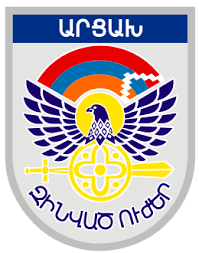
The Armed Forces of Armenia, sometimes referred to as the Armenian Army, is the national military of Armenia. It consists of personnel branches under the General Staff of the Armenian Armed Forces, which can be divided into two general branches: the Ground Forces, and the Air Force. Although it was partially formed out of the former Soviet Army forces stationed in the Armenian SSR, the military of Armenia can be traced back to the founding of the First Republic of Armenia in 1918. Being landlocked, Armenia does not have a navy.

Artsakh, officially the Republic of Artsakh or the Republic of Nagorno-Karabakh, was a breakaway state in the South Caucasus whose territory was internationally recognised as part of Azerbaijan. Between 1991 and 2023, Artsakh controlled parts of the former Nagorno-Karabakh Autonomous Oblast of the Azerbaijani Soviet Socialist Republic, including its capital Stepanakert. It had been an enclave within Azerbaijan from the 2020 Nagorno-Karabakh war until the 2023 Azerbaijani offensive, when the Azerbaijani military took control over the remaining territory controlled by Artsakh. Its only overland access route to Armenia after the 2020 war was via the 5 km (3.1 mi) wide Lachin corridor, which was placed under the supervision of Russian peacekeeping forces.

Samvel Andraniki Babayan is an Armenian military commander and politician from Nagorno-Karabakh. He was one of the founders and main commanders of the Artsakh Defence Army during the First Nagorno-Karabakh War and became a hero among Armenians for the military victories achieved under his command.
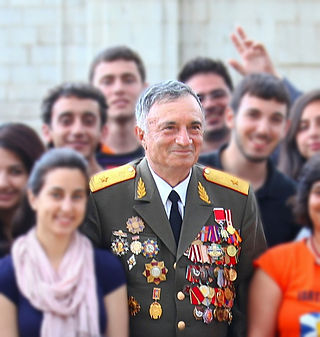
Arkady Ivani Ter-Tadevosyan, also known by his nom-de-guerre Komandos, was a Soviet and Armenian Major General, a military leader of the Armenian forces during the First Nagorno-Karabakh War and Armenia's former Deputy Minister of Defense. Ter-Tadevosyan is best known as the commander of the operation to capture the town of Shushi on 8–9 May 1992.

The Armenian Ground Forces is the collective term for personnel branches of the General Staff of the Armed Forces of Armenia that are responsible for the country's land-based operations. It was established in conjunction with the other components of Armenia's military on January 28, 1992, several months after the republic declared its independence from the Soviet Union. The army's first head was the former deputy commander-in-chief of the main staff of the Soviet Ground Forces, Norat Ter-Grigoryants.
The military history of the Republic of Artsakh contains information about the history of military actions or events performed by or in the Republic of Artsakh.

Seyran Musheghi Ohanyan is an Armenian general and politician currently serving as a deputy in the National Assembly of Armenia. He served as Defence Minister of Armenia from 14 April 2008 until 3 October 2016. A native of Nagorno-Karabakh, he participated in both the first and second Karabakh wars, and from 2000 to 2007 served as defence minister of the unrecognized Republic of Artsakh.

Arayik Vladimiri Harutyunyan is an Armenian politician who served as the fourth president of the Republic of Artsakh from May 2020 to September 2023. Under his predecessor Bako Sahakyan, he served as the sixth and last Prime Minister from 2007 until the abolishment of that position in 2017 and as the first State Minister of the Republic of Artsakh from 2017 until his resignation in 2018. Harutyunyan led Artsakh through the 2020 Nagorno-Karabakh War with Azerbaijan, during which the republic lost most of the territory under its control. He resigned on 1 September 2023 in the midst of the Azerbaijani blockade of Nagorno-Karabakh.
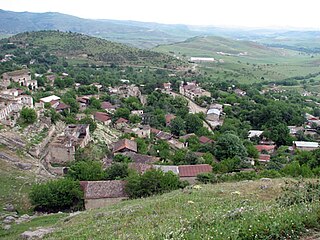
Tugh or Togh is a village in the Khojavend District of Azerbaijan. The village had a mixed Armenian-Azerbaijani population before the First Nagorno-Karabakh War. The Azerbaijani inhabitants fled the fighting in 1991, and the Armenian population fled the village during the 2020 Nagorno-Karabakh war.
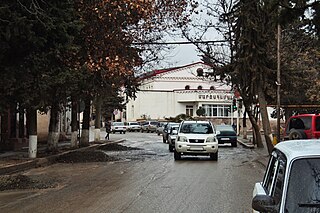
Martuni or Khojavend is a town in Khojavend District of Azerbaijan, in the region of Nagorno-Karabakh. After the First Nagorno-Karabakh War, it came under the de facto control of the breakaway Republic of Artsakh as the centre of its Martuni Province. The town returned to Azerbaijan's control after the 2023 Nagorno-Karabakh offensive.
Operation Goranboy was a large-scale military offensive by Azerbaijan in the summer of 1992. Its aims were to take complete control of the entire territory of Nagorno-Karabakh and put a decisive end to the secessionist Nagorno-Karabakh Republic (NKR). This offensive is regarded as a successful breakthrough by the Azerbaijani Army and marked the peak of Azerbaijani success throughout the entire six years of the First Nagorno-Karabakh War.

Movses Hranti Hakobyan is a former senior Armenian military official and the former commander of NKR Defense Army and former Chief of the General Staff of the Armenian Armed Forces. From 19 November 2018 until his resignation on 18 November 2020, Hakobyan served as the Chief Military Inspector of the Armed Forces.
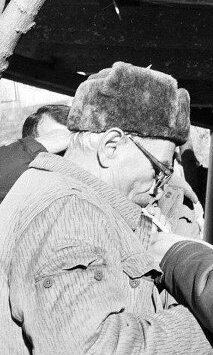
Kristapor Ivani Ivanyan was a Soviet and Armenian lieutenant general. He fought in both World War II and the First Nagorno-Karabakh War. He was one of the founders of the Nagorno-Karabakh Defense Army.

Vitaly Mikhaili Balasanyan is an Artsakhi politician and retired general. He served as the head of the National Security Council of the self-proclaimed Republic of Artsakh from November 2016 to November 2019 and again from December 2020 to January 2023. For his services in the First Nagorno-Karabakh War, he was awarded the country's highest title, Hero of Artsakh. He previously served as a member of Artsakh's National Assembly. He twice ran, unsuccessfully, for the office of President of Artsakh.
The Ministry of Defence of Artsakh was a government agency of the unrecognized Republic of Artsakh. It was the executive body in implementing defence policies of the Artsakh Defence Army. The final minister of defence was Lieutenant General Kamo Vardanyan. Following an Azerbaijani assault on 19 September 2023, Artsakh agreed to dissolve itself by 1 January 2024.
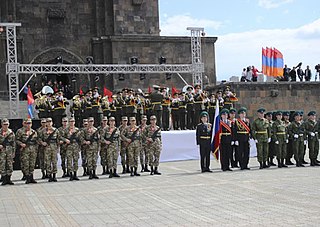
Shushi Liberation Day is a national holiday celebrated in Armenia and formerly in the self-proclaimed Republic of Artsakh. It is commemorated on both 8 and 9 May as a way to celebrate the anniversary of the Capture of Shushi and the Siege of Stepanakert from Azerbaijani forces in 1992. Being both former Soviet republics, the holiday also commemorates the traditional Victory Day celebrations on 9 May, commemorating the surrender of Nazi Germany at the end of the Great Patriotic War in 1945. The holiday serves as the official holiday of the Artsakh Defense Army, which was established on this day.
Jalal Anatolii Harutyunyan is an Armenian general from the Republic of Artsakh who formerly served as Commander of the Artsakh Defense Army and Minister of Defense of Artsakh. He commanded the Artsakh Defense Army during the 2020 Nagorno-Karabakh War until his dismissal on 27 October 2020 after being wounded in action. He was appointed Head of the Military Control Service of the Ministry of Defense of Armenia in February 2021. Harutyunyan was suspended from this role in connection with a criminal case opened against him in September 2022.
Mikael Alberti Arzumanyan is a Lieutenant General from the Republic of Artsakh, who formerly served as the Commander of the Artsakh Defence Army and Minister of Defence. He was born on 12 June 1973 in Stepanakert in the Nagorno Karabakh Autonomous Oblast.

Suren Barseghyan is an Armenian military personnel, participant of the Second Nagorno-Karabakh war, commander of the World Volunteer Detachment. In 2020 he was awarded the Hero of Artsakh military award, which is the highest honorary title of the self-proclaimed Republic of Artsakh.

Kamo Bahaturi Vardanyan is an Armenian military officer from the Republic of Artsakh. He served as the last Minister of Defence of Artsakh and Chief of Staff of the Artsakh Defence Army.
